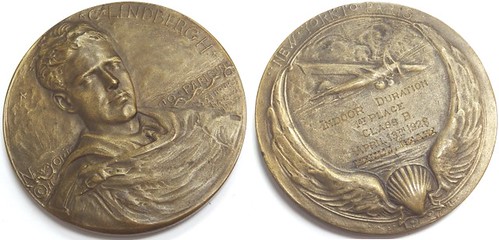
PREV ARTICLE
NEXT ARTICLE
FULL ISSUE
PREV FULL ISSUE
THE LINDBERGH “LONE EAGLE” MEDAL AS AN AWARD MEDAL
Steve Bishop submitted this article about the use of the Lindbergh “Lone Eagle” medal as an award medal. Thanks! -Editor
There were a large number of commemorative medals issued in honor of Charles Lindbergh after his solo trans-Atlantic flight in May of 1927. One of the most common of these is the one generally referred to as the “Lone Eagle” medal, issued by the Medallic Art Company (MACO) shortly after Lindbergh’s historic achievement. Designed by Charles Hinton, the 2 ¾” medal was originally sold for $1.50 in Bronze, $5.50 in Fine Silver and $95.00 in 14k Gold. The obverse has a portrait of Lindbergh wrapped in a robe, with NY to Paris flight data to either side. On the reverse is The Spirit of St. Louis with a border of wings and a shell at lower center symbolizing flying and the ocean. The sun setting in the background denotes the passing of a day, during which the Lone Eagle winged his way to France. I have seen a large number of these medals offered over the couple of years I have been collecting Lindbergh medals, but recently I have seen two offered that are distinctive: they are engraved to individuals as award medals. As opposed to custom-designed medals tailored especially to the accomplishment being honored, this was probably an economical alternative. The first of these that I saw was sold on eBay in July (I was outbid) and was presented to William F. Whyte in 1931 for “Outstanding Achievement in Scholarship and Citizenship” at Bronxville High School in New York. 
William F. Whyte was a sociologist with a passion for reform who wrote ''Street Corner Society,'' the trailblazing 1943 study of Italian-American gangs in the North End of Boston. Mr. Whyte was a professor emeritus of sociology at Cornell University. In all, he wrote 20 influential books. But his first, ''Street Corner Society,'' was the keystone of his career. Translated into Chinese, Japanese, German, French, Italian and Spanish, the book sold more than 270,000 copies, making it one of the best-selling sociology books in history. He died in 2000 in Ithaca, N.Y. at the age of 86. It is unclear why this particular medal was chosen for this particular award, unless it was because there is a convenient blank space on the reverse, perhaps placed there deliberately by the designer Hinton at the request of MACO? The second one I saw was bought by me shortly after the first one sold. It came from a seller in Birmingham, Michigan, a suburb of Detroit, who probably acquired it from the estate of the recipient of the award in 1928. Nevill Geake passed away in Ferndale, Michigan (another suburb of Detroit) in May of 2015 just days after his 101st birthday. Although an engineer by trade, he decided at the age of 32 to quit his job and for the next 51 years, he was proprietor of the landmark Geake's Sporting Goods in Ferndale. Born in Detroit in 1914, he apparently spent his entire life in the Detroit area. 
What is most interesting about this medal is that, unlike the scholastic excellence that was honored in the 1931 award, this medal was awarded as a prize for a competition directly related to the subject matter of the medal. First place in “Indoor Duration, Class B” refers to a model airplane flying competition. Model airplane flying contests became especially popular after Lindbergh’s flight and have persisted to this day. The “Class B” refers to the surface area of the wings available for aerodynamic lift. The planes probably were powered by a single rubber band, or were hand-launched gliders. Prizes were awarded based in total flight time in the air, hence “Duration”. Nevill’s interest in technology, as evidenced by his participation in a model airplane competition at the age of fourteen, apparently lasted into adulthood, since he became an engineer. It might also have been piqued by his encounter with Henry Ford, whom he met as a young boy as Ford was going door to door selling stock in a new venture he was to create, later to become the Ford Motor Company. Wayne Homren, Editor The Numismatic Bibliomania Society is a non-profit organization promoting numismatic literature. See our web site at coinbooks.org. To submit items for publication in The E-Sylum, write to the Editor at this address: whomren@gmail.com To subscribe go to: https://my.binhost.com/lists/listinfo/esylum All Rights Reserved. NBS Home Page Contact the NBS webmaster 
|